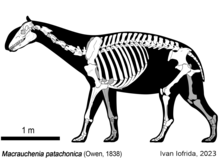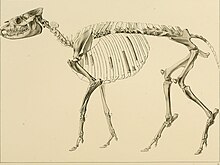Litopterna
| Litopterna Temporal range:
| |
|---|---|

| |
| Skeleton of Macrauchenia (Macraucheniidae) | |

| |
| Skeleton of Diadiaphorus (Proterotheriidae) | |
| Scientific classification | |
| Domain: | Eukaryota |
| Kingdom: | Animalia |
| Phylum: | Chordata |
| Class: | Mammalia |
| Clade: | Panperissodactyla |
| Order: | †Litopterna Ameghino 1889 |
| Subgroups | |
| |
Litopterna (from
Ancient Greek: λῑτή πτέρνα "smooth heel") is an extinct order of South American native ungulates that lived from the Paleocene to the end of the Pleistocene-early Holocene around 63 million-12,000 years ago, and were also present in Antarctica during the Eocene. They represent the second most diverse group of South American ungulates after Notoungulata.[1] It is divided into nine families, with Proterotheriidae and Macraucheniidae being the most diverse and last surviving families.[2]
Diversity


The body forms of many litopterns, notably in the limb and skull structure, are broadly similar to those of living
bunodont (rounded cusp) molar teeth, which is largely unique to litopterns among South American native ungulates.[2][1] Litopterns of the mid-late Cenozoic had hinge-like limb joints and hooves similar to those of modern ungulates, with the weight being supported on three toes in macraucheniids and one in proterotheriids, with the protherotheriid Thoatherium developing greater toe reduction than that present in living horses.[1] Macraucheniids had long necks and limbs.[4] Members of the macraucheniid subfamily Macraucheniinae saw the progressive migration of the nasal opening to the top of the skull,[5] which was often historically suggested to indicate the presence of a trunk, though other authors have suggested that a moose-like prehensile lip is more likely.[6]
Ecology
Litopterns were likely
hindgut fermenters.[3] At least some macraucheniids like Macrauchenia are suggested to have been mixed feeders feeding on both browse and grass.[7] Sparnotheriodontids are suggested to have been browsers.[8] Some proterotheriids are suggested to have been browsers,[9] while some members proterotheriid subfamily Megadolodinae like Megadolodus have been suggested to have been omnivorous with at least part of their diet consisting of hard fruit.[2]
Evolutionary history
Litopterna, like other "South American native ungulates" is thought to have originated from groups of archaic "
tapirs) as part of the clade Panperissodactyla, with the split from Perissodactyla being estimated at around 66 million years ago.[10][11] The relationship of Litopterna to other South American native ungulate groups is uncertain, though it may be closely related to the "condylarth" group Didolodontidae. The earliest litopterns appeared during the early Paleocene, around 63 million years ago.[1]
Aside from South America, sparnotheriodontids are also known from the
Quaternary extinction event, along with most other large mammals in the Americas, co-inciding with the arrival of the first humans to the continent. It is possible that hunting had a causal role in their extinction.[12][13][14][1]
Classification
This section relies largely or entirely on a single source. (April 2022) |
- Order Litopterna[15]
- Proacrodon
- Family Protolipternidae
- Family Indaleciidae
- Family Sparnotheriodontidae
- Family Amilnedwardsiidae
- Family Notonychopidae
- Superfamily Macrauchenioidea
- Family Adianthidae
- Proectocion
- Adianthinae
- Family Macraucheniidae
- Family Adianthidae
- Superfamily Proterotherioidea
- Family Proterotheriidae
References
- ^ S2CID 213737574.
- ^ S2CID 261638835.
- ^ PMID 34403434.
- S2CID 86091386.
- S2CID 89219979.
- S2CID 92143497.
- S2CID 233678648.
- ISSN 0305-8719.
- S2CID 133673644.
- S2CID 4467386.
- PMID 28654082.
- S2CID 251050063.
- ^ Marshall, L. G.; Cifelli, R. L. (1990). "Analysis of changing diversity patterns in Cenozoic land mammal age faunas, South America". Palaeovertebrata. 19: 169–210. Retrieved 2018-10-08.
- S2CID 88305955.
- ^ "PBDB". paleobiodb.org. Retrieved 2022-04-29.
Further reading
- McKenna, Malcolm C; Bell, Susane K (1997). Classification of Mammals Above the Species Level. New York: Columbia University Press. ISBN 978-0-231-11013-6.
External links
Wikimedia Commons has media related to Litopterna.
- An artist's rendition of a Red Académica Uruguaya megafauna page
